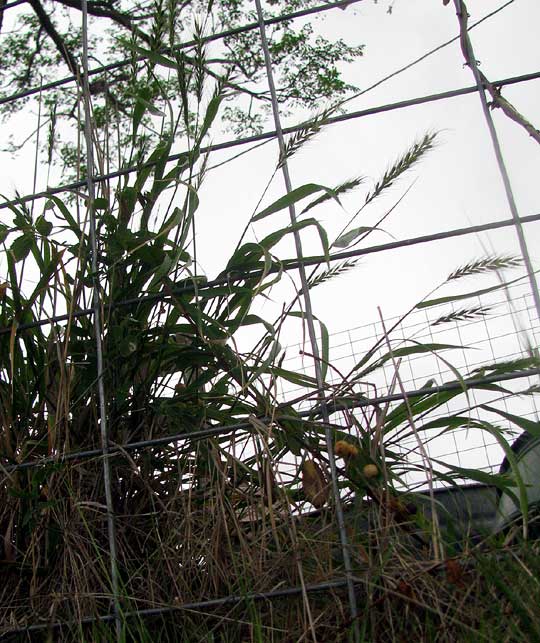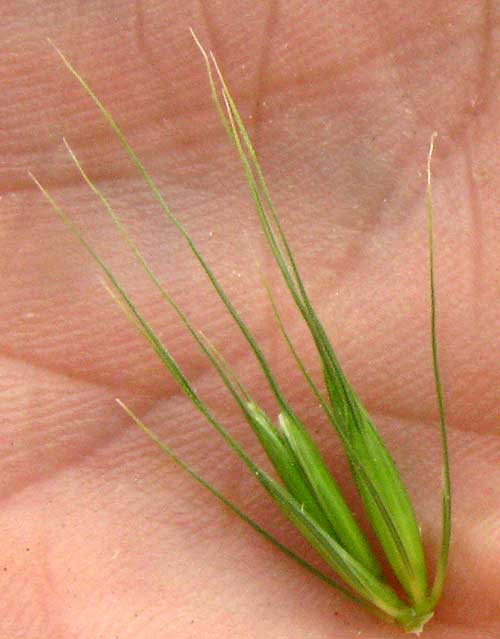Excerpts from Jim Conrad's
Naturalist Newsletter

from the May 25, 2014 Newsletter issued from the Frio Canyon Nature Education Center in the valley of the Dry Frio River in northern Uvalde County, southwestern Texas, on the southern border of the Edwards Plateau; elevation ~1750m (~5750 ft); N29.62°, W99.86°; USA
CANADA WILD RYE
A deer fence around the abandoned garden at the red cabin I lived in two winters ago is grown up at its base with various interesting "weeds." One of those is a distinctive grass with spikelets arranged in stem-top heads reminiscent of bristly bottle brushes. You can see what I mean below:

Up close, individual spikelets display a very specialized and unique structure that quickly identifies the grass as a kind of wild rye, genus Elymus, shown at the top of this page.
In that picture, one feature making this a wild rye is that at the picture's bottom a pair of spikelets -- not a single spikelet or a cluster of them -- is attached to the flowering stem, or rachis. A little higher up the rachis but on the opposite side, another pair of spikelets arise, and so on, on up the inflorescence, causing the rachis to be configured like a zigzagging stepladder.
An even more distinctive field mark designating the wild ryes is to be seen in the grass's glumes. To better make out the needle-like glumes, a shot of two spikelets removed and in my hand is below:

Normal grass spikelets have at their bases two modified bracts, the glumes, situated opposite one another, like the wide-open mandibles of a bird with his mouth pointed skyward. One or more florets arise above the two glumes. The spectacular thing about wild rye spikelets is that not only are their glumes not opposite one another, being side by side, but also instead of being like a bird's upward-pointing, open mouth, they're stiff and needle-like, forming thin-sided Vs, with florets arising above the V's base.
In our area two wild rye species commonly occur. The main field mark distinguishing the two species is that one, Virginia Wild Rye, produces much thicker, flatter glumes than the other, which is Canada Wild Rye. Back in Mississippi we looked at the Virginia Wild Rye. You might check the picture of that species' glumes partway down the page at http://www.backyardnature.net/n/h/wild_rye.htm.
You can see that our present wild rye's glumes are much slenderer, because now we have Canada Wild Rye, ELYMUS CANADENSIS. Canada Wild Rye is a native species found throughout much of Canada and most of the US, though generally uncommon or absent in the US southeastern and Pacific states, but extending southward into northern Mexico.
Canada Wild Rye has to be fairly tough and adaptable to thrive over such a large area, and finding our plant surviving where most of its companion weeds were severely stunted or didn't even emerge this year because of the drought, shows that it's drought tolerant as well. It's also noted for doing well in partly shaded areas.
This is a fine grass. Despite the needlelike "awns" produced on its flowering heads, the awns are soft and livestock like grazing on Canada Wild Rye.